
4 benefits of free trade agreements to your supply chain
Supply chain disruptions have hit businesses hard in recent years. This is in addition to the lack of transparency and uncertainties already involved, with the rules around trading changing frequently. All of this makes it very hard for small and medium businesses (SMEs) to operate smoothly. This is why, as an SME-owner, you need to build greater resilience against changing global supply chain dynamics.
One way is with regional free trade agreements (FTAs). You’ve probably heard how it can help businesses save costs and have better access to more markets. But beyond that, FTAs can help your business plan ahead and be safeguarded against any trade and regulatory uncertainties.
Know your FTAs
FTAs are arrangements between two or more countries that make it easier to conduct trade between them. Here are some of the most important regional FTAs you should know about:
What it is: Agreement between the member countries of the Association of Southeast Asian Nations (ASEAN), as well as Australia, China, Japan, New Zealand and South Korea.
What it covers: International trade in goods, services, investment, economic growth and technical cooperation, intellectual property, competition and dispute settlement. RCEP is the world's largest trade agreement and includes countries that make up almost a third of the world's population and GDP.
What it is: Agreement between 11 countries in Japan-Asia Pacific (JAPAC) and the Americas: Australia, Brunei, Canada, Chile, Japan, Malaysia, Mexico, New Zealand, Peru, Singapore and Vietnam.
What it covers: International trade in goods and services, investment, intellectual property, labor, the environment and e-commerce
What is it: Comprehensive trade agreement between the European Union and Vietnam, whose goal is to improve trading conditions between the countries involved. It also safeguards labor rights, environmental protection and intellectual property rights.
What it covers: International trade in goods, services, reduction of non-tariff barriers, protection of intellectual property, public procurement and e-commerce.
4 underutilized benefits of FTAs for SMEs
So we know that FTAs make it easier for businesses to conduct trade between participating countries. But how exactly do they do that?



1. Stronger supply chain resilience
When countries participate in FTAs, they are committed to making international trade as seamless as possible for their businesses. For SME owners like yourself, this means there is less worry about disruptions in trade flow and sudden changes in rules. This makes trade much more straightforward, and it’s also easier for you to integrate your supply chain across member countries.
2. Simpler border processes and reduced red tape
FTAs enable less cross-border delays across countries, which means your product can get to market quickly. Member countries aim to keep customs procedures simple and predictable to ensure goods don’t get held up due to a miscommunication or misunderstanding of the rules. Ultimately, such seamlessness also makes international shipping cheaper for your business.






3. Lower total supply chain cost
FTAs aim to reduce costs for businesses involved. For cross-border transactions, this is typically in the form of reduced tariffs or even complete removal of tariffs in some cases. For small businesses, the savings can be huge, particularly in markets where previously there were high tariffs but where your business needed to operate to satisfy customer demand.
4. Fairer and more transparent trade
Without some kind of oversight, cross-border businesses are likely to be overlooked in favor of local businesses. FTAs ensure fairness for member markets, so businesses like yours can be judged based on the quality and price of their products, not preferential treatment or biased regulation.



We can all agree that FTAs offer great benefits. But to build a truly resilient global supply chain for your business, you need to establish a highly efficient and reliable network of international shipping and logistics services between the AMEA-EU (Asia Pacific, Middle East and Africa-Europe) and Intra-AMEA regions. This includes optimizing transportation routes and systems, improving transit times, and ensuring the safety and security of goods throughout the supply chain. It also means ensuring that your supply chain is able to adapt quickly to changing market conditions.
This is where a trusted logistics provider like FedEx can help. Here’s what FedEx offers.
Strong, stable presence across AMEA-EU
FedEx has a highly efficient international shipping network that covers more than 220 countries and territories across AMEA-EU and Intra-AMEA. With 13 hubs across 650 airports, we have the world’s largest cargo airline. So there’s no need to worry about abrupt disruptions in your shipments, as our ample fleet and local presence allow us to support you across all your regional markets.
This is where a trusted logistics provider like FedEx can help. Here’s what FedEx offers.
Tech tools and resources that enable cross-border e-commerce
FedEx provides automation tools and innovative tech like the FedEx® Delivery Manager that make your job easier, while guaranteeing customer satisfaction.
You can use the FedEx® Delivery Manager to:
schedule a specific delivery date or time
authorize a signature release
redirect a package to a FedEx location for pickup
track your packages
see delivery times
identify any potential issues
As a small business owner, you have enough to worry about. Don’t let supply chain resilience be one of your concerns. Instead, leverage the four advantages provided by FTAs and work with a trusted logistics provider like FedEx. Then, you can focus on growing your business.

